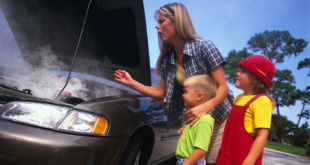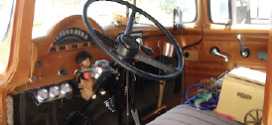 Some are new, some are old, some are flat, but the best tires are the ones that are inflated properly. We take tires on our cars for granted much of the time. I learned after crashing on a wet mountain road that tires are not the place to cut costs.
Some are new, some are old, some are flat, but the best tires are the ones that are inflated properly. We take tires on our cars for granted much of the time. I learned after crashing on a wet mountain road that tires are not the place to cut costs.
I’ve cut tires in half with a hacksaw just to see what a sectioned tire looks like. I’ve contacted tire engineers to find out what load and speed ratings really mean. Every person that drives should be checking their tires at least once a week. It really isn’t a chore and you don’t have to get your hands dirty. As you approach your car do a visual inspection, just a walk around, looking for cuts, abrasions and under inflation. You should be checking your tire wear indicators which are raised material between treads spaced evenly around the circumference of the tire. When the treads wear down to the wear bars the tires need replacing.
The front (steering) tires are more important than the rear tires. If you’ve been diligent in your tire maintenance — rotation, inflation and alignment — your tires should be wearing fairly evenly. Ideally all four tires get replaced at one time, but if that’s not going to happen due to budget constraints then replace at least the two in the front.
 When buying tires keep in mind not all tires are the same, even when they may have identical ratings. All the important information about the tire is on the tire, but to comparison shop you need to know what these codes mean. The top row of numbers will read, for example, P185/75R14 82s. P means passenger tire. LT means light truck. 185 is the width in millimeters. 75 is a ratio of sidewall height to width (this number is a percentage). R means radial-ply construction. 14 is the wheel diameter in inches. 82 is the load rating (an 82 load rating correlates to 1,047 pounds). S is the speed rating. An s speed rating correlates to 112 mph.
When buying tires keep in mind not all tires are the same, even when they may have identical ratings. All the important information about the tire is on the tire, but to comparison shop you need to know what these codes mean. The top row of numbers will read, for example, P185/75R14 82s. P means passenger tire. LT means light truck. 185 is the width in millimeters. 75 is a ratio of sidewall height to width (this number is a percentage). R means radial-ply construction. 14 is the wheel diameter in inches. 82 is the load rating (an 82 load rating correlates to 1,047 pounds). S is the speed rating. An s speed rating correlates to 112 mph.
Then check the tread-wear rating, traction, and temperature limits. The second row of numbers is a code developed by the DOT to grade tire quality. For example, the code Tread-wear 360 Traction A Temperature A can be broken down to read: Tread-wear 360 is compared to a standard reference number of 100 so a tread-wear of 360 means this tire should last 3.6 times longer. Traction A measures a tires stopping ability on wet pavement in a straight line. Ratings range from AA to C with C being the worst. Temperature rating measures dissipation of heat with A being the best to C being the worst.
Maximum air pressure is stamped on the side wall. Never exceed this recommendation. Lastly is the tire’s manufacture date on all tires made after 2000. For example, Re: DOT U2LL LMLR 4208 only 4208 is for us. 42 means 42 week of the year and 08 means 2008. This code tells us this tire was made in Oct of 2008.
 Baja Review A community newspaper serving Ensenada, Valle de Guadalupe, and Rosarito in Northern Baja California
Baja Review A community newspaper serving Ensenada, Valle de Guadalupe, and Rosarito in Northern Baja California




